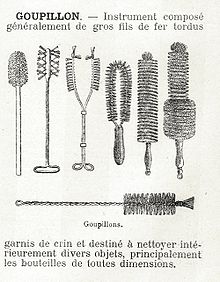Reuse of bottles
This article needs additional citations for verification. (March 2024) |

A reusable bottle is a bottle that can be reused, as in the case as by the original bottler or by end-use consumers. Reusable bottles have grown in popularity by consumers for both environmental and health safety reasons. Reusable bottles are one example of reusable packaging.
History

Early glass bottles were often reused, such as for milk, water, beer, soft drinks, yogurt, and other uses. Mason jars, for example, were developed and reused for home canning purposes.
With returnable bottles, a retailer would often collect empty bottles or would accept empty bottles returned by customers. Bottles would be stored and returned to the bottler in reusable cases or crates.
Beginning in the second half of the 20th century, many bottles were designed for
Though Sweden has had a standard glass bottle recycling system since 1884, in response to the increased litter from single-use containers,
In Germany, reusable glass or plastic (PET) bottles are available for many drinks, especially beer and carbonated water as well as soft drinks (Mehrwegflaschen). The
Environmental consequences

The reuse of containers is often thought of as being a step toward more sustainable packaging. Reuse sits high on the waste hierarchy. When a container is used multiple times, the material required per use or per filling cycle is reduced.
Many potential factors are involved in environmental comparisons of returnable vs. non-returnable systems. Researchers have often used
Arguments in favor of reusing bottles, or recycling them into other products, are compelling. It is estimated that in the U.S. alone, consumers use 1,500 plastic water bottles every single second. But only about 23% of
Bottles intended for reuse by households


Reusable drinking bottles for water, coffee, salad dressing, soup, baby formula, and other beverages have gained in popularity by consumers in recent years, due to the costs and environmental problems associated with single use plastic bottles. Common materials used to make reusable drinking bottles include glass, aluminum, stainless steel, and plastic. Reusable bottles include both single and double wall insulated bottles. Some baby bottles have an inner bag or bladder that can be replaced after each use.
See also
- Bottle recycling
- Bottled water
- Reverse logistics
- Reusable packaging
- Refill (scheme)
- Solar water disinfection
References
- S2CID 6850034
- ^ Schriever, Norm (2013-07-29). "Plastic Water Bottles Causing Flood of Harm to Our Environment". Huffington Post. Retrieved 2018-10-27.
Books, general references
- Yam, K. L., "Encyclopedia of Packaging Technology", John Wiley & Sons, 2009, ISBN 978-0-470-08704-6
